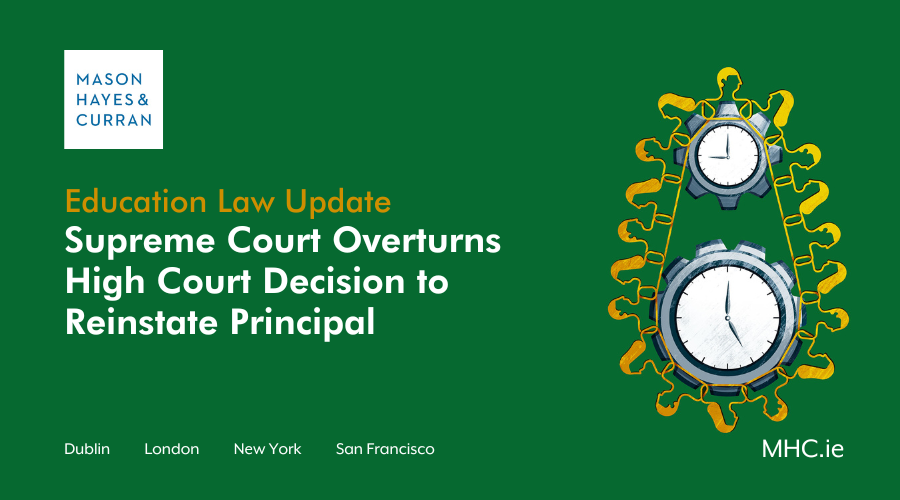Supreme Court Overturns High Court Decision to Reinstate Principal

Our Education team has successfully appealed the decision of the High Court to reinstate a primary school principal who was dismissed because of deficiencies in the school’s enrolment figures. We review the Supreme Court decision.
The Supreme Court has held that the High Court, Labour Court and Workplace Relations Commission erred in law. When they ordered that the dismissed principal be reengaged in the school. The Supreme Court held that reengagement is an exceptional remedy. It requires a clear and balanced explanation detailing precisely why a relief which is out of the ordinary is being granted in a particular case.
Background
This is a long running case that lasted over 13 years. It arose as a result of an incident at the school which then unearthed an issue into its enrolment figures. Following an investigation by the school and an inspector in the Department of Education, the principal was dismissed. He appealed his dismissal to the Disciplinary Appeals Panel in the Department of Education. The Disciplinary Appeals Panel upheld the decision of the Board of Management to dismiss the principal.
The principal then appealed the decision to the Workplace Relations Commission (WRC). The WRC found that the dismissal was unfair and ordered his reengagement. The matter was appealed to the Labour Court which also found in favour of the principal.
High Court
The Board of Management then appealed the matter to the High Court on a point of law. The High Court dismissed the appeal but found that the Labour Court had been in error regarding the date of the deemed reengagement of the principal. It set that order aside and reengaged the principal from the actual date of dismissal, November 2015. The High Court also ordered the payment of all arrears of salary to be paid immediately, refused a stay on the High Court order and made an order that costs should be on a legal practitioner and client basis. This would entail a higher legal costs liability than is usual.
Supreme Court
The Board of Management appealed to the Supreme Court. The Supreme Court held that the High Court had exceeded the proper scope of an appeal which was on a point of law only. Instead, the High Court decision had amounted to a decision on the merits of the case which included findings and conclusions which were inconsistent with the findings and conclusions of the Labour Court. The Supreme Court ordered that the decision of the High Court varying the order of the Labour Court should be set aside and the order of the Labour Court deeming reengagement to have taken effect from 1 September 2017 should be restored.
The Supreme Court also stated that the decision of the lower decision-making bodies to order reengagement was wrong in law. To order such a remedy there has to be an exceptional basis. The Supreme Court referred to the employer’s asserted lack of trust in the employee who they have unfairly dismissed and the appointment of a new principal in the school on a permanent basis since 2016.
The Supreme Court also noted that neither the Labour Court nor the WRC made any finding about the validity of the appointment of the new principal. The Supreme Court went further and stated “it is indeed a valid criticism of both decisions that they did not consider the impact of their decision on the position of the new principal at all”.
Some of the issues the Supreme Court noted that should have been considered were that there had been a bitter dispute between the parties consisting in part of parents and teachers at the school and where two teachers had given evidence. In addition, no assessment was made of any changes in curriculum or of teaching practice, or the responsibility of a principal having become deskilled by being out of the school environment for a number of years.
The Supreme Court held that the Board of Management of a school cannot be treated as the equivalent of a board, or indeed, the management of a commercial enterprise. It does not have flexibility in the terms of employment which it may offer teachers and cannot, for example, negotiate a settlement of a dispute in a way which a commercial body could. The Supreme Court noted that life must go on, that a working school would require a principal to be in place and that the school community would reasonably expect that. It would not be reasonable to expect the school or a business to remain in limbo pending the outcome of protracted legal proceedings. Given the context of a small national school in this case, this particular aspect would apply in force.
Finally, the Supreme Court held that the High Court was incorrect in issuing costs to the principal on the legal practitioner and client basis. Instead, the Supreme Court found that the costs should have been awarded on a party and party basis. The Supreme Court also requires the principal to pay back the Board of Management for almost two years of salary that was awarded to him by the High Court. However, given the passage of time in this case the Supreme Court ordered that the re-engaged principal should remain in his role in order to avoid opening new and old wounds.
Conclusion
The Supreme Court has outlined what decision-making bodies should take into account when awarding reinstatement and reengagement under the Unfair Dismissal Act 1997. Reengagement and reinstatement should be reserved for the most exceptional circumstances.
This decision is an important one for Boards of Management. The Supreme Court quite correctly considered the falsification of records or fraudulent returns a matter that certainly could be considered misconduct and conduct which could justify dismissal.
For more information, contact a member of our Education Law or Employment Law & Benefits teams.
The content of this article is provided for information purposes only and does not constitute legal or other advice.
Share this:




